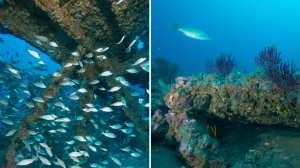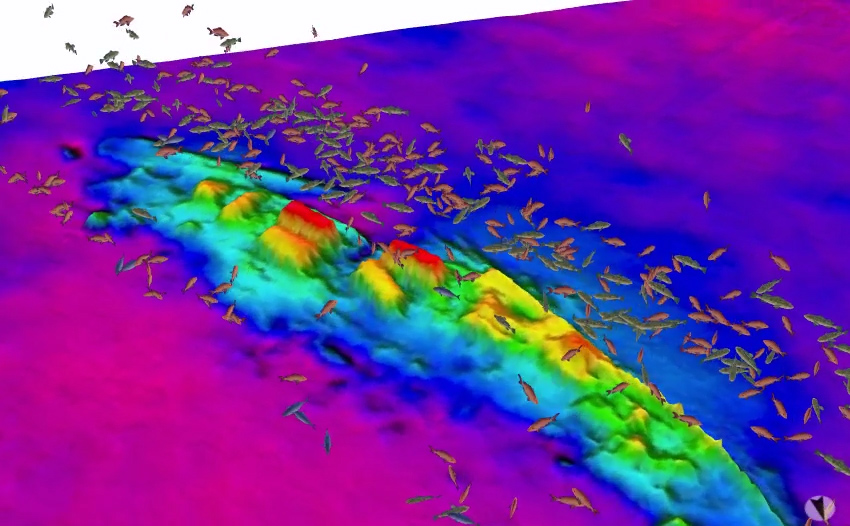Increased calls for enhancing ocean habitats through artificial reefs and proposals for increasing offshore energy development require science to understand the impact and habitat value of these artificial structures on marine ecosystems. Harnessing technologies, including fishery echosounders and remotely-operated vehicles, we collect and synthesize data on fish communities, benthic communities, and physical characteristics to understand how these reefs form habitat for diverse species.

Why We Care
The southeastern USA continental shelf hosts naturally-occurring rocky reefs, artificial reefs, and shipwrecks. Rocky reefs range from flat-pavements to rubble fields and extensive ledges. Artificial reefs are structures, such as ships, planes, and concrete modules, intentionally sunk to enhance fish habitat. Shipwrecks sank unintentionally, often during storms or war.
These natural and artificial reefs provide homes for a diversity of commercially and recreationally important fish species, including tropical, subtropical, and temperate species. Species include those in the snapper-grouper complex, whose status is of particular concern because of their recreational and commercial value and their depressed numbers, as well as top predators.
Understanding how fish communities use these reefs can help guide management decisions, spatial planning for offshore development, and habitat enhancement to ensure healthy reef ecosystems and sustainable ecosystems.
What We Are Doing
We collect data on seafloor habitat structure, fish communities and the reefs that they occupy using visual and acoustic methods, including:
-
-
- High-resolution seafloor habitat mapping
- Fishery echosounder surveys (splitbeam, multibeam)
- Scientific diving surveys
- Remotely-operated vehicle (ROV) surveys
- Time-lapse video surveys
-
We then synthesize these data into maps and visualizations to test hypotheses on how artificial and natural reefs provide habitat for a diversity of species, including top predators like sharks and snapper and grouper. For example, we seek to answer questions, such as:

-
-
- How do characteristics of reef habitats regulate community structure?
- How does the habitat function of natural reefs differ from artificial habitats?
- Are there differences in fish communities among reef types?
- How do top predators utilize these reef types?
-
What We Are Finding
-
-
- Rocky reefs, artificial reefs, and shipwrecks provide ecologically valuable habitats for a diversity of marine species, ranging from reef fishes to top predators.
- Rocky reefs and artificial reefs share some ecological functions but unexpectedly differ in others.
- Our research demonstrates that artificial reefs fill key ecological roles, such as hosting high abundances and biomasses of reef fish, supporting elevated abundances of top predators, and facilitating tropical fishes at range edges.
-
Benefits of Our Work
-
-
- These findings help guide ecosystem based management decisions, spatially-explicit planning by government agencies, and habitat enhancement strategies by state and federal management agencies. For example, this research:
- Addresses a science need of Monitor National Marine Sanctuary by understanding the
ecological function of shipwrecks that are within their proposed sanctuary expansion. - Fulfills science needs of state habitat enhancement programs by understanding ecological roles of artificial reefs.
-
Next Steps
-
-
- Continued assessments of reefs to elucidate longer term temporal patterns in fish communities and biomass.
- Expand surveys to cover broader spatial areas to understand more about how fish move between and occupy natural and artificial habitats
-
